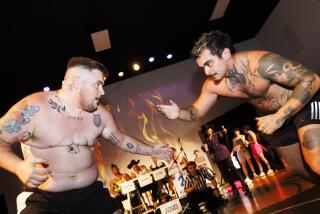KOREATOWN : <i> Ssireum</i> Wrestlers Throw Weight Around for New Fans
- Share via
It may not have done what the recent World Cup games did for soccer, but last weekend’s 21st annual Los Angeles Koreatown Multicultural Festival helped solidify the growing local popularity of an ancient Korean sport and national pastime.
The sport is ssireum , a style of wrestling similar to Japanese sumo that has been popular in Korea since the Three Kingdoms period, which lasted from 57 BC to AD 668.
Now, in the Korean American community of modern-day Los Angeles, ssireum is enjoying an increase in prominence, largely due to the efforts of the Korean Folk Wrestling Assn. in U.S.A., an informal network of retired professional wrestlers and younger enthusiasts formed three years ago.
“We have over 200 members now,” said association member and longtime amateur wrestler Sam Chong, 38, as he wound down after a match during the festival at Ardmore Park, next to the sand-filled ring in which ssireum is traditionally performed.
“A lot of Korean people enjoy ssireum, so it is becoming very popular here,” he said.
This was the second year the association sponsored an amateur ssireum competition at the Koreatown Festival. Out of the almost 20 men who lined up around the sand ring to compete, several were beginners, many of them young, second-generation Korean Americans.
“I came here and saw them play last year,” said Thomas Hyung, a 20-year-old Cal State Northridge student, as he awaited his turn. “I wrestled in high school, so I wanted to try this out.”
According to tradition, ssireum originated in China--where ancient tomb paintings show wrestlers in positions similar to those used today--and was carried into the Korean peninsula by migrating tribes. Originally a method of self-defense, ssireum grew into a popular spectator sport played at village festivals and remains one of the most popular spectator sports in Korea, with competitions drawing several thousand onlookers, as well as a large television audience.
The sand-filled ring used is about 22 feet in diameter. Each player wears shorts and a long cotton belt called a sapha , which he wraps around his waist and right leg.
A match consists of three rounds, each three minutes long. At the beginning of each round, the players squat close together on the sand, holding onto one another’s sapha. When the referee gives the signal, they begin to wrestle. The first player to fall loses the round. If a player wins two out of three rounds, he wins the match.
In ancient times, the winner of a ssireum competition would usually receive a bull as a prize. Now that live bulls are no longer practical, a small bull trophy is sometimes handed to the winner instead.
There are two weight classes on Korean professional teams: hanla-jangsa (220 pounds or less), and baekdo-jangsa (over 220 pounds). Weight is flexible, however, for local amateurs, said Gene Kim, chairman of the Koreatown Assn. and a ssireum fan.
The Korean Folk Wrestling Assn. in U.S.A. is headed by Kwang Il Kim, a retired wrestler who competed professionally in Korea in his youth. Although the association does not have a set gathering place, members often meet at various Tae Kwon Do studios throughout the Korean community to play and practice, usually learning of the gatherings through word of mouth, he said.
Older wrestlers teach ssireum techniques to new recruits, many of whom had their first exposure to the sport through television or attending one of the association’s occasional public competitions.
As part of this year’s Koreatown Festival activities, Kim arranged for several professional teams to visit from South Korea and compete at the Grand Olympic Auditorium a few days before the amateur competition.
Kim hopes that the professional event, which drew more than 2,000 spectators, helped kindle greater interest in ssireum not only among Korean Americans, but among the general population as well.


